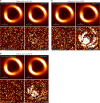Strongly lensed repeating fast radio bursts as precision probes of the universe
- PMID: 30237406
- PMCID: PMC6147950
- DOI: 10.1038/s41467-018-06303-0
Strongly lensed repeating fast radio bursts as precision probes of the universe
Abstract
Fast radio bursts (FRBs), bright transients with millisecond durations at ∼GHz and typical redshifts probably >0.8, are likely to be gravitationally lensed by intervening galaxies. Since the time delay between images of strongly lensed FRB can be measured to extremely high precision because of the large ratio ∼109 between the typical galaxy-lensing delay time [Formula: see text] (10 days) and the width of bursts [Formula: see text] (ms), we propose strongly lensed FRBs as precision probes of the universe. We show that, within the flat ΛCDM model, the Hubble constant H0 can be constrained with a ~0.91% uncertainty from 10 such systems probably observed with the square kilometer array (SKA) in <30 years. More importantly, the cosmic curvature can be model independently constrained to a precision of ∼0.076. This constraint can directly test the validity of the cosmological principle and break the intractable degeneracy between the cosmic curvature and dark energy.
Conflict of interest statement
The authors declare no competing interests.
Figures






Similar articles
-
Fast radio bursts and the radio perspective on multi-messenger gravitational lensing.Philos Trans A Math Phys Eng Sci. 2025 Apr 10;383(2294):20240121. doi: 10.1098/rsta.2024.0121. Epub 2025 Apr 10. Philos Trans A Math Phys Eng Sci. 2025. PMID: 40205867 Free PMC article. Review.
-
Strong gravitational lensing of explosive transients.Rep Prog Phys. 2019 Dec;82(12):126901. doi: 10.1088/1361-6633/ab4fc5. Epub 2019 Oct 21. Rep Prog Phys. 2019. PMID: 31634885
-
A gravitationally lensed quasar with quadruple images separated by 14.62 arcseconds.Nature. 2003 Dec 18;426(6968):810-2. doi: 10.1038/nature02153. Nature. 2003. PMID: 14685230
-
A bright burst from FRB 20200120E in a globular cluster of the nearby galaxy M81.Nat Commun. 2024 Aug 28;15(1):7454. doi: 10.1038/s41467-024-51711-0. Nat Commun. 2024. PMID: 39198464 Free PMC article.
-
The discovery and scientific potential of fast radio bursts.Science. 2022 Nov 11;378(6620):eabj3043. doi: 10.1126/science.abj3043. Epub 2022 Nov 11. Science. 2022. PMID: 36356125 Review.
Cited by
-
Fast radio bursts and the radio perspective on multi-messenger gravitational lensing.Philos Trans A Math Phys Eng Sci. 2025 Apr 10;383(2294):20240121. doi: 10.1098/rsta.2024.0121. Epub 2025 Apr 10. Philos Trans A Math Phys Eng Sci. 2025. PMID: 40205867 Free PMC article. Review.
-
Multi-messenger gravitational lensing.Philos Trans A Math Phys Eng Sci. 2025 May;383(2295):20240134. doi: 10.1098/rsta.2024.0134. Epub 2025 May 1. Philos Trans A Math Phys Eng Sci. 2025. PMID: 40308122 Free PMC article.
References
-
- Petroff E, et al. FRBCAT: the fast radio burst catalogue. Publ. Astron. Soc. Aust. 2016;33:e045. doi: 10.1017/pasa.2016.35. - DOI
Publication types
Grants and funding
LinkOut - more resources
Full Text Sources
Other Literature Sources

